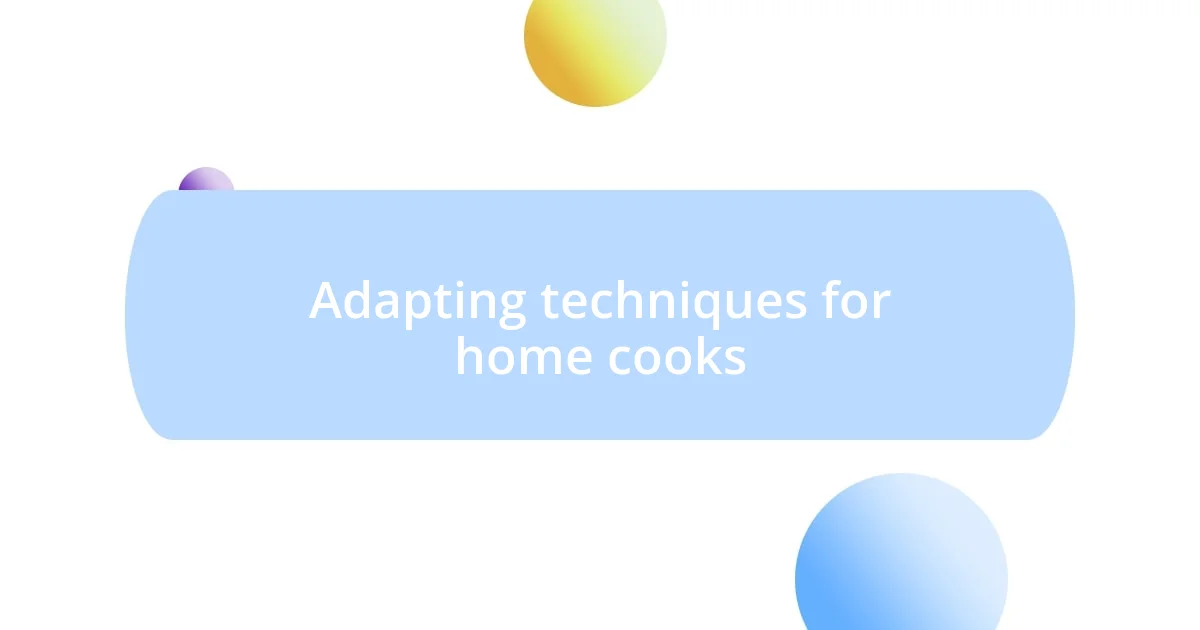Key takeaways:
- Sous vide cooking revolutionized meal preparation, allowing precise temperature control and enhancing flavor retention across various foods, including proteins and vegetables.
- Molecular gastronomy methods, such as spherification and foaming, fuse culinary art with science, creating innovative dining experiences that challenge traditional cooking norms.
- Implementing fermentation and exploring new textures in dishes transforms everyday cooking into a creative adventure, showcasing how innovative techniques can enhance flavors and presentations.

Introduction to innovative cooking techniques
Cooking has always been a canvas for creativity, and innovative culinary techniques push those boundaries further. I still remember the first time I tried sous vide cooking; it felt like alchemy in my own kitchen. Watching that perfectly cooked steak emerge from the water bath was a revelation—imagine how precise you can get with temperature control!
As I explored methods like molecular gastronomy, I found myself mesmerized by the combination of science and artistry. Have you ever seen a dish that looks like a piece of art yet tastes like a dream? The textures and flavors created through techniques like spherification are simply mind-blowing. It made me rethink what cooking could be, elevating familiar dishes into extraordinary experiences.
Diving into innovative techniques opens up a whole new world of flavor profiles and presentations. I can’t help but wonder how each method has its own personality, shaping not just the food but also the cooking process. Isn’t it exciting to think about the endless possibilities waiting to be discovered in our kitchens? Each technique invites us to experiment and question what we know about cooking, ultimately transforming our relationship with food.

Understanding sous vide cooking
Sous vide cooking is a method that has transformed how I approach meal preparation. The essence of sous vide lies in vacuum-sealing food in bags and immersing them in a water bath at a precise temperature, resulting in evenly cooked dishes that retain moisture and flavor. I vividly recall preparing a tender chicken breast that was infused with herbs—something I’d never achieved through traditional cooking. It felt like I had unlocked a secret to culinary perfection.
What really fascinates me about sous vide is the complete control it offers over the doneness of food. For instance, when I experimented with precision cooking for my weekend brunch, I realized I could set my steak to exactly medium-rare and walk away for an hour without worrying about overcooking it. The beef was perfectly pink throughout, and my friends couldn’t believe how succulent it was. This technique not only saved time but also allowed me to focus on side dishes and presentation.
As I delved deeper into this cooking style, I discovered that sous vide isn’t just about steak or chicken; it opens up endless possibilities, from vegetables to desserts. Have you ever had a perfectly cooked egg that was silky and just the right texture? Using sous vide for eggs has elevated my breakfast game like nothing else. Each cooking experience taught me something new, reinforcing the charm and versatility of this innovative culinary technique.
| Aspect | Sous Vide Cooking |
|---|---|
| Temperature Control | Precise and consistent cooking |
| Flavor and Moisture Retention | Enhances natural flavors and retains moisture |
| Cooking Time | Longer cooking periods; can be left unattended |
| Versatility | Applies to a variety of foods, including proteins, vegetables, and desserts |

Exploring molecular gastronomy methods
Molecular gastronomy is truly a thrilling adventure in the kitchen, blending culinary art with scientific discovery. I’ll never forget the first time I created a dish using spherification; watching those little spheres burst in my mouth was both an exhilarating and strange experience. It felt like I was combining childhood wonder with sophisticated dining, transforming a simple fruit puree into something akin to caviar—something that tantalized not just my taste buds, but my imagination as well!
Here are a few key methods that define the molecular gastronomy experience:
- Spherification: Involves creating spheres that burst with flavor, often used for fruit juices or sauces.
- Foaming: Uses a siphon to infuse air into liquids, creating light and airy flavor explosions that elevate the dish’s visual appeal.
- Gelification: Transforms liquids into gels, which can be cut or molded into various shapes, adding both texture and presentation.
- Emulsification: Combines oil and water-based ingredients using lecithin or other agents to create stable, velvety sauces and dressings, elevating standard dishes to gourmet levels.
- Sous Vide: While it’s a separate technique, it’s often combined with molecular gastronomy to achieve perfect textures and flavors through precise cooking.
Embracing these innovative techniques has allowed me to push my culinary boundaries, encouraging creative experimentation. The process itself is a delightful mix of anticipation and surprise, and every dish I create through molecular gastronomy feels like a small celebration of food science, bringing joy not only to me but to those I serve.

Implementing fermentation in dishes
Implementing fermentation in my cooking has truly revolutionized how I think about flavor and preservation. I remember the first time I tried my hand at making kimchi. The process felt like a deliciously messy experiment, and waiting for those crunchy vegetables to develop that unique tang was a lesson in patience. When I finally tasted it, the explosion of umami and spice was like a delightful symphony bursting in my mouth.
I’ve also discovered that fermentation can elevate even the simplest of dishes. Take sourdough bread, for instance. I never realized how magical the combination of flour, water, and wild yeast could be until I started nurturing my own starter. Watching it bubble and grow was invigorating! The first loaf I baked carried a depth of flavor that store-bought bread simply couldn’t match—each slice was airy and slightly sour, waking my taste buds like an unexpected surprise.
Have you ever considered fermenting vegetables or fruits? I was initially hesitant, but after a few successful trials, I felt empowered to experiment with a variety of produce. One memorable creation was fermented carrots with ginger—a crisp, zesty side that added brightness to my meals. It not only introduced a delightful flavor but also taught me that fermentation is a gateway to creativity and experimentation that transforms everyday cooking into an adventurous journey.

Creating flavors with foam techniques
Creating flavors with foam techniques has opened up a new dimension in my culinary journey. I still remember the first time I whipped up a savory foam using a siphon—it felt like magic! As I released the fluffy cloud of garlic foam onto my dish, I was captivated by how something so airy could pack such a bold flavor punch. The interplay of texture and taste brought a new life to the dish, making it not just a meal but an experience.
One memorable instance was when I experimented with a beetroot foam. I blended roasted beets with a touch of vegetable stock, then siphoned it up to create a rich, vibrant foam. As I plated it beside seared scallops, the burst of color and taste was enchanting. How could something so simple make such an impact? It sparked conversations at the table, drawing attention not only to the visual appeal but also to the unexpected nuances of flavor each spoonful delivered.
Foam techniques have become a gateway for me to push the boundaries of creativity in cooking. Have you ever tried infusing a cocktail with a delightful citrus foam? I did just that for a gathering with friends, and the combination of tangy lime zest and airy texture elevated the drink from ordinary to extraordinary. Every sip was an explosion of flavor that left everyone wanting more, showcasing just how innovative ideas in the kitchen can truly transform an experience.

Adapting techniques for home cooks
Adapting innovative culinary techniques for home cooks can be incredibly rewarding and surprisingly easy. When I first tried sous vide cooking, I was amazed at how a simple immersion circulator could elevate my meals. I remember placing a ribeye steak seasoned with salt in the water bath, entrusting it to gentle precision. It was thrilling to think that I was harnessing restaurant-quality techniques right in my kitchen, resulting in perfectly cooked meat that was tender and bursting with flavor.
I’ve also found that simple tools can make a huge difference. Have you ever played with a food processor in ways you never expected? The first time I used it to quickly emulsify a homemade salad dressing, I was overwhelmed by the luscious creaminess I achieved. It was a little moment of triumph that made me realize that incorporating professional techniques doesn’t have to feel intimidating. Instead, it can feel like an invitation to explore and expand your culinary repertoire.
Experimenting with textures has been another delightful avenue for me. One evening, while preparing a simple soup, I tried incorporating a crispy element by frying some thinly sliced vegetables. The contrast between the silky soup and the crunchy topping was revelatory! It made me think—how many time have we just left our dishes as they are? I realized that by embracing these innovative techniques, I could create layers of flavor and excitement that not only enhance the meal but turn cooking into a wonderful exploration of creativity.

Reflecting on my culinary journey
Reflecting on my culinary journey has been a blend of awe and inspiration. I can still picture that moment when I first tasted a dish that utilized liquid nitrogen; the icy mist enveloped the food, creating a sensory experience I never knew was possible. How could something so surprising become a part of my cooking? It awakened a curiosity in me to explore the intersections of science and flavor, shifting my perspective dramatically on how ingredients can behave.
Another pivotal experience was when I attended a workshop on molecular gastronomy. I remember stepping into the kitchen, filled with the aromatic allure of unusual ingredients waiting to be transformed. I still smile when I think about crafting edible spheres filled with flavorful juices—there was something genuinely magical about bursting them in my mouth. That workshop wasn’t just about techniques; it was a reminder of the creativity that cooking can unleash within us, inviting us to break the rules and rethink tradition.
Sharing my innovative culinary creations with family and friends has been equally rewarding. I recall a dinner party where I served a deconstructed dessert, with each component arranged artistically on the plate. Seeing my guests’ eyes light up with curiosity was a heartwarming moment. It made me wonder: isn’t that the essence of cooking? Not just creating food, but crafting experiences that evoke feelings and stimulate conversations? My journey continues to fuel my passion for innovation, reminding me that every dish has the potential to tell a story.














